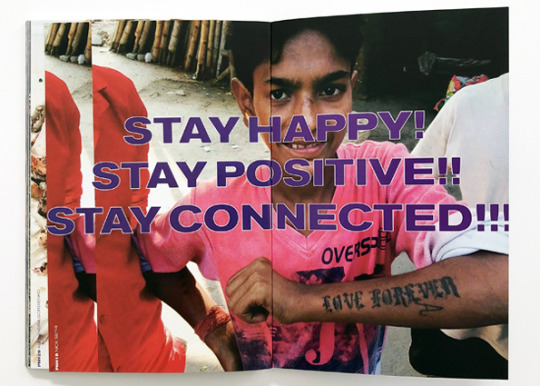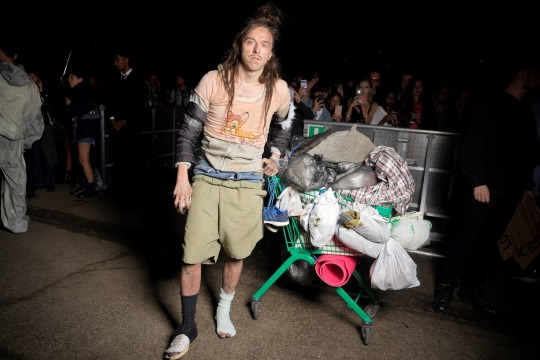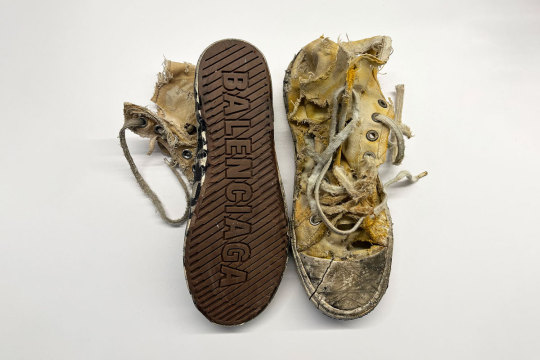Don't wanna be here? Send us removal request.
Text
I don’t think my grandmother was even that keen of cats.
A review of Somerset House's 'Cute' exhibition.

The Cute exhibition at Somerset House begins in a small pink room, and hanging on the wall we see what is also the start, but in this case of a global culture; the first cat memes captured by photographer Harry Pointer, dating back to 1872. Next to it, following the feline theme, there is a vast collection of 300 china cats inside a vitrine. It is Andy Holden’s ‘Cat-tharsis’ (2016). Playing on the headphones hanging underneath the glass cube, Andy talks about what this collection that his grandmother left to him after her passing, meant to his grandmother; how these cats gave her a sense of control, how she used them as a catalyst for the love within her. He also talks about what cats mean to our culture, to our history. He speaks on the UK economy, and how charity shops - the place where her grandmother collected a great number of these figures- might represent the avid mass-consumption of the British public caused by capitalism. An incredibly interesting and unexpected piece on culture and grief, which a quote from, names the title of this text.
If there is a country knows how to do cute, it is Japan. With a whole room dedicated to Japanese vintage illustrations and art, we can see how these drawings were used as a form of escapism from the after-war times during the 90s, and how Japan influenced the western world with the introduction of the kawaii. Jun’ichi Nakahara’s beautiful book cover illustrations (1913-1983) of women represent a beginning for manga and anime style. Weirdly enough, upon entering the room they called my attention as they resembled ‘Girl with a Kitten’ by Lucien Freud, which coincidentally does match the theme of this particular exhibition.
The Hello Kitty room is probably one of the most talked about parts of the exhibition. With two walls full of Hello Kitty branded objects ranging from notebooks, to rice cookers, to coin purses... A shrine to miss Kitty, and an ode to this epitome of capitalism for having influenced a whole generation, not only of children, but of adults as well. It is interesting to see for yourself how the symbol and brand spread their wings through essentially every demographic, and benefited from the over-consumption boom of the 90s and early 2000s. Sadly, apart from this display of products, the room has the icky feeling of an instagram-like photobooth space without adding any artistic value to the exhibition. But, did you know Hello White (her actual name, I’ve learned) " [...] lives in a London suburb, and dreams of becoming a pianist and poet? [That] her birthday is on the 11th of November, her height is measured as five apples, and she weighs the same as three?" Maybe we’re all just like Hello Kitty, but just measured with a lot more apples.
The exhibition follows with great artworks, like Mike Kelley’s iconic ‘Aah… Youth!’ (1990), a critique of “childhood fetishisation”, and Wang Ping’s ‘An Emo Nose’ (2015), a bright and colourful animation depicting- in a surprisingly charming and accurate way- adult loneliness. The middle of the room is overflowing with objects, which the previous section helped contextualise: A Yung Lean poster, a SADBOYS bucket hat, a bright pink ski mask, a bag of smiley face stamped drugs, a Sylvanian Families toy set, a tamagotchi, a duolingo meme, a Charli XCX vinyl, an Animal Crossing gameplay... I found that, seeing what to me are such quotidian objects in an exhibition space made me laugh. They do however, encapsulate my childhood and teenage years, and quite frankly, are a big explanation of who I am. As someone that grew up with unrestrained access to the internet since the age of 11, I can say that these objects essentially raised me. It made me feel tribal, like I was in a global inside joke. These objects also showcase how cuteness can be used as an advantage politically and how effective it is for conveying a message, making the reality of an ugly theme (oppression, systematic injustice, etc) look easier to digest and divulge.
The last section I visited was an interactive space. To tell you the truth, I did not enjoy these rooms as much as I would've liked, and the reason why has nothing to do with the exhibition itself. The room was full of animalistic and screaming under-12 year old kids, and families with prams blocking stairways and hallways, and parents using the space as a playpen for their kids to run around. I stopped at the arcade, where you could play games that followed the theme of the exhibition. As I was giggling away playing the “linear visual novel about a Froggy chilling a pot”, children began running around impatiently, in the hopes that someone would free up one of the arcade looking screens. Maybe it’s just me, but I don’t have the patience.
With a combination of humour, social commentary and critique, the exhibition encapsulates the story of a culture and phenomenon we are still living through. It showcases how we’ve created a subculture for the use of evading the terrifying thought of the internet times and the digitalisation taking over our worlds. It displays a wide arrange of topics all within the main theme, that is kept consistent through out. How cuteness “contains, domesticates and translates our desires”, and how it lives in a great part of who we all are. The exhibition, and now this text, concludes with a question: Does cute’s shiny new confidence represent its apotheosis in our late capitalist world? Or rather, does this sheen allow cute to undermine the very foundations of the neoliberal regime which spawned it with an ability to not only challenge the norm, but to transform it?
1 note
·
View note
Text
Poverty-core, Consumerism and the Commodification of Fashion
How fashion is weaponized against the working class.
A significant change has occurred in the media landscape with the advent of digital identities and instantaneous mass communication. It is no longer a domain reserved for public figures and highly influential people. Marginalised groups are increasingly able to express themselves in ways that were previously impossible thanks to this change.
The end of religious morality and the widespread propagation of news concerning injustice have also been made possible by the digital revolution. As a result, people are more conscious of privilege and, occasionally, condemn others who do not use their advantages to address systemic injustices. This phenomenon of collective ethicality and activism has sparked a profound change in the perception of wealth and background among the opulent. The super wealthy are no longer considered ‘cool’.
In the past, people with little resources felt more pressured to present an image of wealth, frequently making an effort to look as wealthy as possible. This is due to the fact that poverty is more than just financial hardship; it encompasses limitations that go well beyond what is in one's bank account and shapes how both society and the individual in question view themselves and each other. People who have lower income experience increased anxiety and social scrutiny, and they frequently have to deal with the stigma of being called lazy or inferior.
However, a notable transformation is now underway. There is an increasing desire to be associated with authenticity and individuality, to show a testament to hard work. Individuals that can afford to, in response, are embracing an aesthetic that seemingly rejects traditional consumerism and seeks to comprehend the challenges faced by ordinary people, i.e., 'bloke-core'. They are eager to demonstrate that their privilege does not define their success, while failing to realise that their ability to pick and choose how they look is one of their biggest privileges. This newfound perspective is viewed as a way to make themselves more relatable and humanise their public image.
Throughout history, fashion has functioned as a language, serving various purposes, from conveying authority to rebelling against societal norms. The emergence of what can be termed 'the aesthetics of poverty' represents a fascinating development. Poverty, ironically, is now being rebranded into a form of performance art for the convenience of the rich.
An example of this can be seen in the recent presence of Tommy Cash at the Diesel AW23 and SS24 Milan Fashion Week runway shows. In these appearances, he consistently embraces and accentuates the aesthetics associated with poverty, dressing as an “old cleaning lady” and a “homeless man”, all without conveying any profound message beyond the mockery of marginalised social groups. This raises questions about the boundaries of art and fashion. Advocates for these performances argue that art is intended to stimulate conversation and provoke emotions, regardless of personal likes or dislikes.

Tommy CashPhoto by Swan Gallet/WWD via Getty Images
This shift in the perception of wealth and the adoption of poverty as an aesthetic, underscores the evolving dynamics of privilege, rebellion, and expression in a contemporary society. It invites reflection on the power of art and fashion as tools for challenging established norms and narratives, even if the message they convey is controversial or unconventional. However, it becomes problematic when the messages conveyed are solely for shock value, personal profit and fame. It comes to an appropriation of hardship, allowing individuals like Tommy Cash to detach themselves from the harsh realities and struggles that others endure. Systematic pain and injustice become mere costumes for the wealthy, ones they can shed at the end of the day while still benefiting from their privileges, either directly or indirectly, within a wealth-driven society. It is crucial to emphasise the significance of fashion as a powerful artistic medium and to not confuse this case study with fashion artistry and creativity.
For years, avant-garde designers have delved into the rejection of conventional fashion, aiming to introduce what is known as 'anti-fashion'. This exploration of ugliness has resulted in exceptionally conceptual pieces that have managed to dematerialise garments. “Ugliness”, in this context, provides fashion with a uniqueness that transforms clothing into a fresh experience, one that validates rather than disqualifies it.
The concern arises when a stylistic choice shifts into appropriation due to misguided inspiration and intentions. When the inspiration is drawn from individuals who have no agency in determining what they wear or own, the outfit shifts from being fashionable to being morally questionable.

‘Paris Sneakers’ via Balenciaga
Upon the launch of Balenciaga's Paris sneaker, fashion blogger Ellie Delphine raised concerns about the brand's perceived hypocrisy in its stance against racism. She argued that the Paris Sneaker exemplifies Balenciaga's readiness to capitalise on a “poor aesthetic” by marketing it to rich people, a strategy that appears contradictory to their commitment to anti-racist social justice efforts.
"Racism and poverty are correlated, just saying"- Ellie Delphine, 2022
The unattainable high price-points on these types of designer clothing, leaves the wealthy elite as the only market of this 'poverty aesthetic'. This brings us back to the issue of rich individuals dressing up as 'poor people' for a day, showcasing their excessive wealth.
Expensive clothing and the constant, ever-changing shifts in fashion trends serve as a method of oppression and control, as well as a major driver of fast fashion. Trends serve as an ongoing means for the wealthy to distinguish themselves from the ordinary, yet they often loop back on themselves as fast fashion companies swiftly catch up with them.
Fashion acts as a form of communication and a fundamental criteria by which people are judged. Due to the beneficial financial situation of rich people, they have the ability of strategically manipulating their appearance, thereby controlling their interactions with the world and how the world perceives them, distancing themselves from fast fashion with the use of sustainable clothing. This underscores the desire for individualism and the somewhat fabricated sense of ethicality and originality.
The issue comes when most often then not, sustainability is not an option for low income individuals because of high price points and lack of inclusion of an array of sizes, leaving only a small percentage of the population able to purchase ethically. Working and middle-class people often invest a significant amount of time, money, and energy on their appearance in order to survive. Lack of wealth is sometimes attributed to the inability to understand how to dress.
In conclusion, fashion, functioning as a language, holds a significant role in shaping power dynamics and societal perspectives. Maybe the initial fashion inspiration drawn from the working class may have begun as a noble artistic pursuit rooted in the cycle of utility and decay. If so, it has for a fact since evolved into a condescending style lacking in any sort of moral depth.
The intricate interplay between consumerism and fashion further complicates this relationship, highlighting the need for a critical examination of the choices, considerations, and judgments we make as consumers. Given the present circumstances, unethical consumerism and consumerism itself remain inevitable, particularly for individuals within the working and middle class.
1 note
·
View note
Text
self-love, my eternal
to look at my own image in awe unbound, sincerely appreciating the person i've become. i've been through every moment lived with myself. my constant, for as long as i have left. self-love, my eternal companion. in my heart i embody all the love i receive, and i radiate the love i give others. in every glance, in every touch, in every prayer, it lives within me; i am my own light, my blessing, my love
0 notes
Text
i am sick again
today i realised how you've started to pop back in my thoughts like a seasonal flu, and how relieved i had been forgetting you. i don't know what has changed, but i am sick again.
i woke up drowning from a dream where you loved me how i've always wanted you to. it felt cruel from your part. why would you let me remember? i would've never done this to you.
my shoulders drop, heavy. now, i again carry you around with me wherever i go. the truth is i don't know how to let go, and frankly i have given up. i no longer want to be me wanting you, but god knows how i still feel you inside my heart with your hands around my fingers.
i don´t know if i will be okay if i don't hear from you again, but god knows how bad i want to. you have no idea of how much i would've loved you.
0 notes
Text
autumn is my favourite season
the crisp air and the smell of damp asphalt told me something that had been dying had finally gone. it no longer feels like something in me is ending. a brittle rain-soaked leaf has just fallen; a bird chirped to celebrate. i am growing, and my bones no longer ache. i am on my way home from the tennis court. i am hungry and content, and the warmth in my body is evaporating as i walk. i am me when i was 13. i am me when i am in my room. i am me when i am alone. and i am alone. i am more me than i was last week.
0 notes
Text
my heart is filled with dog-like devotion
I sit and wait and chase. I devour to love and hope I become change. beneath a vacant sky i silently prayed that you hurt me so you can see how good i can be. in that same spot i still wait for your footsteps, your voice, your shadow. holding on to you like a dog they've yet to put down.
0 notes
Text
full moon respite
i spent all weekend telling the moon how tired i am of wanting, of needing. "how did i ever get out of the house?". the moon would have to know. the moon has seen the life i long for in a million other windows.
i didn't hear anything back.
i spend all night shifting around in my sheets, restless from uncertainty. the morning after, on my way to the park, a white butterfly flew past me, peacefully. and while i read, a wide-eyed robin sung at the arm of the bench. i worry too much.
1 note
·
View note